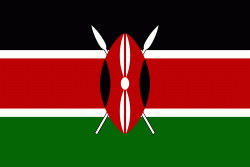Narok
Narok (sometimes referred to as Narok Town) is a town west of Nairobi that supports Kenya's economy in south-west of the country, along the Great Rift Valley. Narok is the district capital of the Narok County and stands as the major centre of commerce in the district. Narok has a population of around 40,000 people, mostly Maasai. The elevation of Narok is 1827 metres (5,997 feet) in altitude.
Narok Town is the last major town when travelling by road from Nairobi to Maasai Mara National Park and Keekorok Lodge. Narok Town stands as a centre for services, business, and finance. For decades, Narok's economy has benefited from tourism, agriculture, livestock keeping and mining. The 30,000-capacity William Ole Ntimama Stadium, a football stadium, is located in Narok.
Narok Town has several public and private primary and secondary schools.
Narok Town is the last major town when travelling by road from Nairobi to Maasai Mara National Park and Keekorok Lodge. Narok Town stands as a centre for services, business, and finance. For decades, Narok's economy has benefited from tourism, agriculture, livestock keeping and mining. The 30,000-capacity William Ole Ntimama Stadium, a football stadium, is located in Narok.
Narok Town has several public and private primary and secondary schools.
Map - Narok
Map
Country - Kenya
 |
 |
| Flag of Kenya | |
Kenya's earliest inhabitants were hunter-gatherers, like the present-day Hadza people. According to archaeological dating of associated artifacts and skeletal material, Cushitic speakers first settled in Kenya's lowlands between 3,200 and 1,300 BC, a phase known as the Lowland Savanna Pastoral Neolithic. Nilotic-speaking pastoralists (ancestral to Kenya's Nilotic speakers) began migrating from present-day South Sudan into Kenya around 500 BC. Bantu people settled at the coast and the interior between 250 BC and 500 AD. European contact began in 1500 AD with the Portuguese Empire, and effective colonisation of Kenya began in the 19th century during the European exploration of the interior. Modern-day Kenya emerged from a protectorate established by the British Empire in 1895 and the subsequent Kenya Colony, which began in 1920. Numerous disputes between the UK and the colony led to the Mau Mau revolution, which began in 1952, and the declaration of independence in 1963. After independence, Kenya remained a member of the Commonwealth of Nations. The current constitution was adopted in 2010 and replaced the 1963 independence constitution.
Currency / Language
| ISO | Currency | Symbol | Significant figures |
|---|---|---|---|
| KES | Kenyan shilling | Sh | 2 |
| ISO | Language |
|---|---|
| EN | English language |
| SW | Swahili language |















